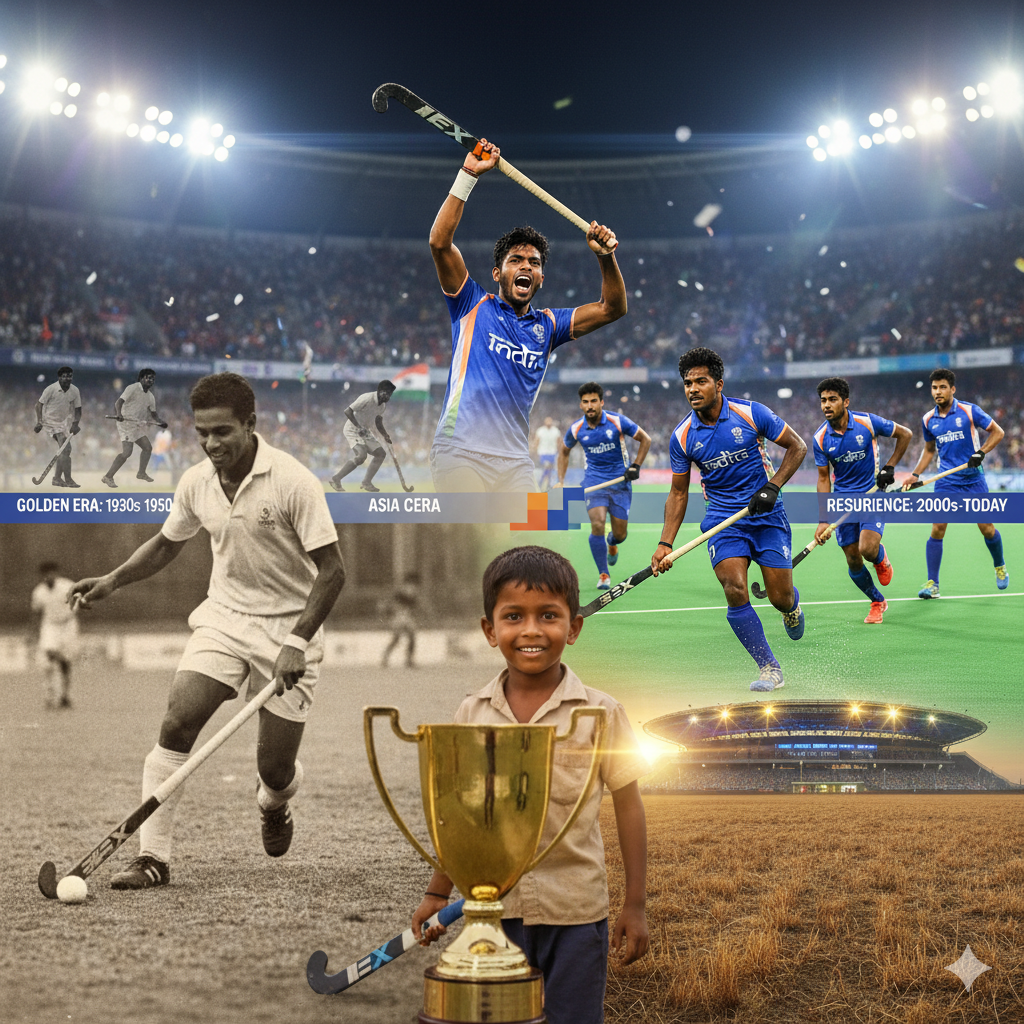
The final whistle echoes across the stadium, and the Indian men’s hockey team erupts in a mix of celebration and relief. A commanding 4-1 victory over Korea in the Hockey Asia Cup final has not only secured the title but also a coveted spot in the upcoming FIH Hockey World Cup 2026. This triumph is more than just a win; it is a powerful symbol of a glorious legacy reclaimed, a testament to resilience, and a sign that Indian hockey is back on the world stage.
For decades, India was an undisputed colossus in international hockey. From the 1928 Amsterdam Olympics to the 1956 Melbourne Games, the men in blue and white secured six consecutive Olympic gold medals, a record that remains a benchmark of dominance. This was the golden age of Indian hockey, a time when the game was played on natural grass, and the country’s innate talent for stick work, rhythm, and intricate passing was unrivalled. Legends like Major Dhyan Chand, often referred to as “The Wizard”, captivated the world with their mesmerising skill. His exploits, including a famous hat-trick in the 1936 Olympic final against hosts Germany, cemented India’s reputation as the global powerhouse of the sport.
However, the golden era began to fade. As the world embraced astroturf. The International Hockey Federation (FIH) first mandated the use of artificial turf for major competitions at the 1976 Montreal Olympics. This was a pivotal moment. The new synthetic surface demanded a fundamentally different style of play. While grass pitches favored India’s traditional strengths; dribbling, intricate stick-work, and a rhythmic, flowing game. Astroturf promoted a faster, more physically demanding style. The ball moved quicker and truer, making individual artistry less effective than a reliance on physical conditioning, power, and speed.
India’s decline was directly tied to its slow adoption of this new technology. While European nations and Australia rapidly invested in astroturf facilities after the 1970s, India lagged behind due to a lack of resources and a failure to recognize the importance of the shift. This created a profound disadvantage; Indian players, trained exclusively on grass, were ill-equipped to compete against nations that had modernized their infrastructure.
This was a critical factor as the team struggled to compete on the international stage, with its last Olympic gold medal coming in 1980. This failure to modernize infrastructure and training methods led to a prolonged period of underperformance, marking a clear and painful timeline of decline from its former glory. The first astroturf pitch in India was laid in 1982 at the National Stadium in Delhi. The delay in adopting this crucial infrastructure contributed significantly to the team’s struggles.
The decline was also a reflection of a shift in the country’s sporting landscape. Cricket, with its rising stars and commercial success, captured the nation’s imagination and media attention. Hockey, once the national obsession, was relegated to the sidelines. A lack of modern infrastructure, limited corporate sponsorship, and inadequate investment meant that Indian players and coaches were often left behind in a fast-evolving global game. The once-mighty team began to struggle at major international tournaments, culminating in a 41-year-long Olympic medal drought after the gold at the 1980 Moscow Games.
But the story of Indian hockey is one of profound resilience, and in the last decade, a remarkable revival has been underway. This resurgence is a direct result of a multi-pronged strategy and support led by the Indian government, Odisha government, Hockey India and the private players like Hero Moto Corp and Tata Steel. A slew of initiatives has been launched to nurture talent from the ground up and provide elite athletes with the support they need.
The Odisha Mining Corporation has been the primary sponsor for both the men’s and women’s national teams. This support, combined with crucial infrastructure like the Birsa Munda Hockey Stadium, has been complemented by private corporations. Companies like Hero MotoCorp and Tata Steel have invested in grassroots and league development, ensuring a robust talent pipeline and providing essential financial backing for the sport.
The Khelo India Scheme has been instrumental in this transformation. By establishing a robust grassroots sports development program, it has created a structured pathway for young talent identification, ensuring that potential stars are not lost in the system. Complementing this is the Target Olympic Podium Scheme (TOPS), which provides financial and infrastructural support to the country’s most promising athletes. Under TOPS, elite hockey players have access to top-tier coaching, international training camps, and sports science support, all crucial for competing at the highest level.
Simultaneously, Hockey India underwent a significant restructuring, professionalising the sport’s administration and focusing on creating a robust domestic league and junior programs. The Hockey India League (HIL), which has been relaunched after a seven-year hiatus under the new sports policy, provided a platform for young players to rub shoulders with international stars, fast-tracking their development and exposing them to high-pressure situations which contributed to the development of competitive tactics in our players on the global stage.
These concerted efforts have borne fruit. The Indian men’s hockey team’s journey over the past 10 years has been nothing short of spectacular. The historic bronze medal at the Tokyo 2020 Olympics (held in 2021) was the culmination of this revival. It was a moment of immense national pride, ending the 41-year wait for an Olympic hockey medal and announcing to the world that India was a force to be reckoned with once again.
Beyond the Olympic podium, the team has consistently performed with distinction. They have won the Asian Champions Trophy twice (in 2016 and 2023) and secured a hard-fought silver medal at the 2022 Commonwealth Games. Their consistent and strong performances in the FIH Hockey Pro League have seen them climb steadily in the world rankings, proving that the Tokyo medal was no fluke but a result of sustained excellence. The rise of young stars, forged in the fires of grassroots training centers and national championships, promises a bright future.
The successful hosting of the Hockey Asia Cup in Rajgir, Bihar, marks a significant milestone in Indian hockey’s resurgence, showcasing the sport’s development beyond traditional hubs. This event highlights a new era of infrastructure and support spreading across the nation. The successful tournament in a non-traditional location like Rajgir demonstrates a broader, pan-Indian commitment to nurturing the sport, from grassroots to elite levels, ensuring a stronger future for Indian hockey
The recent Asia Cup victory is a powerful reminder that the journey continues. It celebrates not just a win but a legacy that is gradually restoring itself. The resilience, dedication, and teamwork on display against Korea are a testament to how far Indian hockey has come. To ensure this momentum is not lost, continued support, investment, and public interest are crucial. The roar of the champions is back, and with every goal, every victory, and every new star that rises, India takes another step toward reclaiming its rightful place as a global hockey powerhouse.
– Clarifeed Editorial Team

